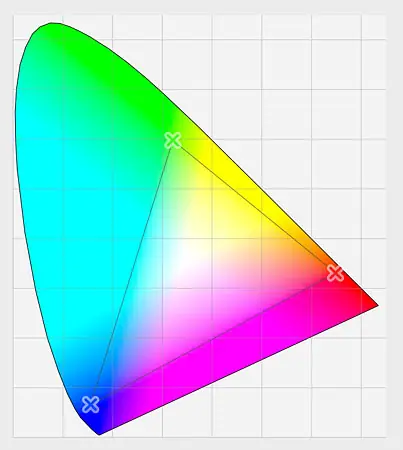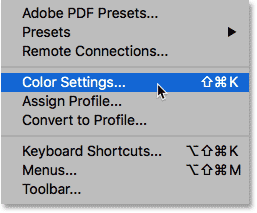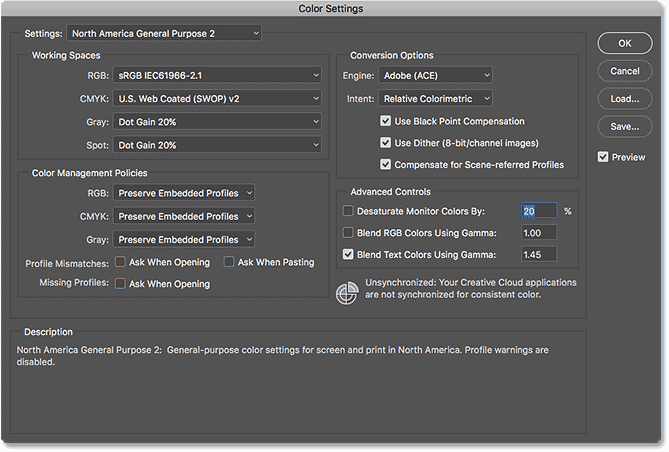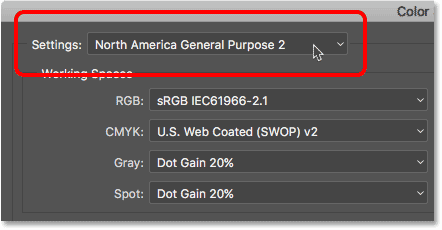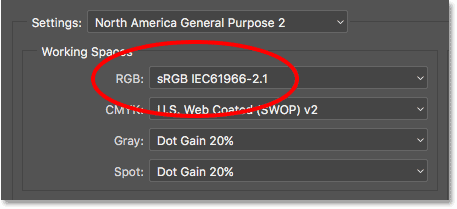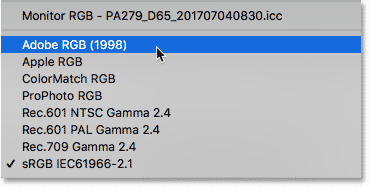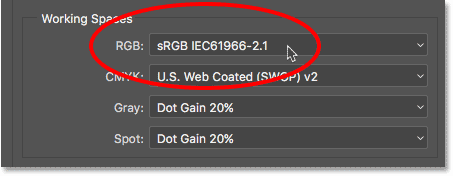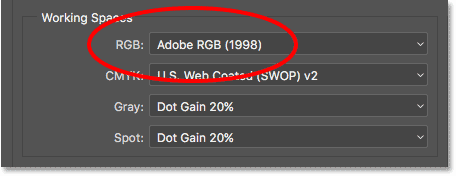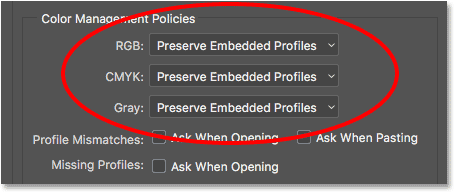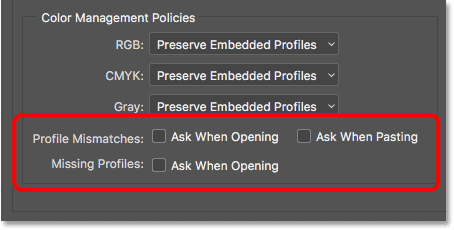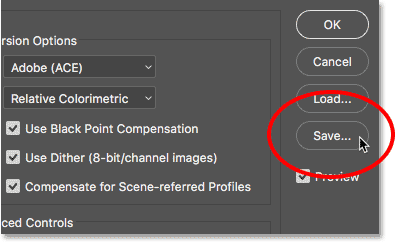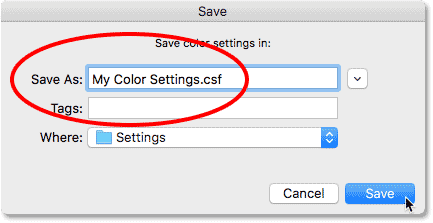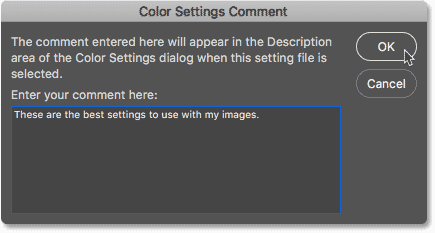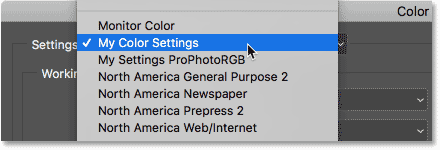Where to find color settings in Photoshop
In Photoshop, the color settings are under a menu Editing . Go up to the Edit menu in the menu bar along the top of the screen. Then choose Color Settings :
How to Photoshop color settings
Color Settings dialog box
The color settings dialog will open. If you haven't seen the Color Settings dialog before
It may seem intimidating at first. But as we'll see, most of Photoshop's default color settings are fine. Actually, there is only one setting we need to change:
New darker dialog
The Color Settings dialog box may look different on your screen depending on which version of Photoshop you are using.
Adobe has made dialog boxes darker in the latest versions of Photoshop CC. Photoshop CS6 and earlier uses lighter dialog boxes. The shade of gray you see makes no difference. Color settings are the same.
Also, in Photoshop CS6 and earlier, some of the more advanced color settings are hidden by default.
Read also:How to reset tools and toolbarYou can access it by clicking on the button “ More options . However, we don't need to change any of the advanced options, so you can safely leave them hidden.
How to Photoshop color settings
Preset default color settings
By default, Photoshop uses a preset set of color settings known as North America General Purpose 2 .
If you are in a different part of the world, your preset might be called something different. If that's the case, that's fine because we'll make our own change anyway:
How to Photoshop color settings
Photoshop workspaces
If we look directly under the name of the preset, we will find a section workspaces . TO Workspace Photoshop says that space color to be used in different situations. For example
Uses Photoshop A single color space for displaying images on the screen. But it uses a different color space for printing.
A color space Specifies a set of available colors. Some color spaces offer a wider range of colors than others.
The particular range of colors offered by it is known as the color space in its own color gradient .
Read also:How to use workspaces in Photoshop CCThere are four options (four different positions) listed under Workspaces. These options are RGB, CMYK, Gray, and Spot. out of the four
The only thing we care about is the first, RGB . That's because RGB is what Photoshop uses to display our images on screen.
The other three options (CMYK, Gray, and Spot) relate to commercial printing. For our purposes here, unless you're working with a commercial printer, you can leave all three options set to their default settings.
How to Photoshop color settings
RGB workspace
Let's look at the RGB workspace. RGB stands for الأحمر ، the green و الأزرق .
It is the workspace that Photoshop uses to view and edit images. Red, green and blue are The three primary colors of light .
Computer monitor, smartphone, TV, and every other type of screen is an RGB device. RGB devices mix different amounts of red, green, and blue light to display each color we see on screen.
Photoshop also uses RGB. Uses color channels To mix different amounts of red, green, and blue to display all the colors we see in our photos.
The exact range of colors Photoshop will reproduce is determined by the color space we've chosen as our RGB workspace. By default, Photoshop sets the RGB workspace to sRGB :
Read also:How to rotate a Photoshop canvas with the Rotate View Tool
How to Photoshop color settings
sRGB color space
The sRGB color space was created in 1996 by Hewlett-Packard and Microsoft. Designed as a standard based on the range of colors available on a typical low end computer monitor.
Even today, most monitors can only display the sRGB color gamut. Because of that, sRGB is the default color space for the web. The default color space for digital cameras is usually set to sRGB.
In fact, many photographers don't realize that there's a color space option buried in their camera menu.
Your home inkjet printer is set up to receive sRGB images by default. Even commercial print labs usually expect you to save your images in the sRGB color space.
For all of these reasons, Adobe decided it would be best to set the default RGB workspace in Photoshop to sRGB.
After all, sRGB is the safe choice. But the safe option is not always the best option. When it comes to editing photos in Photoshop
"Safe" and "best" are definitely not the same thing. The reason is that of all the RGB color spaces that we can choose from, sRGB has the most The smallest range of colors .
How to Photoshop color settings
Human eye vs. sRGB
To help clarify the issue, let's look at a diagram. This graph shows the range of colors available to us when working in the sRGB color space.
The curved outer area represents all the colors the human eye can see. It is not a true representation as it does not show brightness values. But it's still enough to give us a general idea of what's going on.
Inside the larger figure is a small triangle. The area inside the triangle represents the sRGB color range.
None of the colors outside the triangle are available in sRGB. This means that many of the richer, more saturated, and more vibrant colors, especially in green and cine, are not available in the sRGB color space:
Adobe RGB color space
While sRGB is by far the most widely used RGB color space, it is not the only one. And because they offer the smallest range of colors
It's also not the best. The best option is AdobeRGB (1998) . Adobe RGB, created in 1998 by Adobe (which explains the name) provides
A wider range of colors than sRGB. The original purpose was to help our photos look better when printed.
Although printers can print much fewer colors than the number of colors available in sRGB, they can produce more, the deeper, more saturated colors our eyes can see.
Many high-end inkjet printers have the option to switch from sRGB to the Adobe RGB color space so our prints can take advantage of the extended color gamut.
Digital cameras are also capable of capturing far more colors than what is available in sRGB. Many cameras these days
Especially high-end DSLRs, have the option to change the default color space from sRGB to Adobe RGB.
If you shoot in JPEG format, Adobe RGB will allow your images to preserve more of the original colors of the scene.
If your camera supports the raw format, and you capture your photos as raw files, setting the Color Space in your camera makes no difference.
Raw files always capture every color the camera sees. However, Adobe Lightroom and Camera Raw
The two tools we use for raw image processing, both use Adobe RGB as the default RGB workspace.
Human eye vs. Adobe RGB
Let's look at another graph, this time showing the range of colors available in Adobe RGB. once again
The outer shape represents all the colors we can see. The triangle inside the figure represents the range of colors that Adobe RGB can produce.
Notice the size of the triangle this time. While sRGB includes about a third of the visible color gamut, Adobe RGB contains nearly half of all the colors our eyes can see. Most of the difference lies in the greens and cyans
Where the triangle extends into those areas much more than it did with sRGB. Where the sRGB color space is limited to more muted tones, Adobe RGB can produce richer, more vibrant colors:
Should you switch from sRGB to Adobe RGB?
Many digital cameras can capture images in Adobe RGB. Many inkjet printers can only reproduce colors that are available in Adobe RGB.
There are even high-end computer monitors these days that can display almost every Adobe RGB color gamut.
So, should you switch Photoshop's RGB workspace from sRGB to Adobe RGB? In most cases, yes.
Adobe RGB provides a much wider range of colors than sRGB. So if your camera can capture it and your printer can print it, why limit Photoshop to the smaller, more muted sRGB color space?
Reasons to choose sRGB
هناك Number Few reasons why you might want to choose sRGB instead. As we learned earlier, sRGB is the safe choice.
Computer monitors, cameras, and inkjet printers are set to sRGB by default. Also, sRGB is the color space for images and graphics on the web.
If you primarily display your images online, you may want to stick to sRGB. If you are a web designer, then again sRGB may be the best choice.
And if you are new to Photoshop and all this talk of color spaces is very confusing
There's no harm in leaving Photoshop set to sRGB. While sRGB may lack the more vibrant and saturated colors of Adobe RGB, it still has a wide enough color gamut to produce stunning, stunning images.
Reasons to choose Adobe RGB
However, if you are a photographer and want your photos to look their best, especially when printed, Adobe RGB is the best option.
If you shoot in the raw format, Camera Raw and Lightroom both use Adobe RGB as the default color space.
It makes sense then to set Photoshop to Adobe RGB as well. Even if you display your images on the web, there is no reason not to edit them in Adobe RGB.
They will benefit from the expanded Adobe RGB color gamut during the editing process. and when you save them later using the Save for Web dialog box
Photoshop will automatically convert your images to sRGB. in another meaning
If you just want to play it safe, choose sRGB. In almost every other case, Adobe RGB is the best choice.
Photoshop set to Adobe RGB
To start taking advantage of Adobe RGB's expanded color range, all we need to do is change the RGB workspace in Photoshop. Click on “sRGB IEC61966-2.1”:
Then choose AdobeRGB (1998) From the list:
With this simple change, Photoshop will now use Adobe RGB for rendering and editing your images. For best results
Check your digital camera and inkjet printer to see if they support the Adobe RGB color space. If they do, you'll need to set both to Adobe RGB:
Color management policies
Now that we've set Photoshop's RGB workspace to Adobe RGB, there's one set of options we should quickly look at.
thats it Color management policies . Even though we set Photoshop to Adobe RGB, you may find yourself opening images that were saved in sRGB.
It seems like something to worry about, but it isn't. Photoshop is more than capable of handling images that use a color space other than our workspace.
By default, Photoshop will simply keep the image's original color profile. This is exactly what you want. The colors in the image will remain true, and you can edit the image as you normally would without any issues.
We tell Photoshop how to handle these color profile mismatches in the Color management policies section. The RGB, CMYK, and Gray workspaces have their own separate settings.
Again, the only thing we really care about is the first one, RGB. However, it doesn't hurt to make sure all three workspaces are set to Keep embedded profiles , which should be by default:
Missing personal profiles and profiles check boxes
Below the RGB, CMYK, and Gray options are three checkboxes. The first two two allocations for Profile Mismatches
The image you open uses a color profile that differs from your workspace. The third is dedicated for missing profiles Where the image has no color profile at all.
Images downloaded from the web often do not have a color profile associated with them.
If you select (mark) these options, then each time you go to open an image with a different color profile, or without a profile at all
Photoshop will ask you how you want to work with it. To avoid the question and allow Photoshop to open the images as it normally would, leave these options unchecked:
Save the new color settings
Once you've switched from sRGB to Adobe RGB, it's a good idea to save your new color settings.
This way, you can easily return to it again if needed. To save your color settings, click the button save :
Enter a name for your color settings. I'll name mine "My Color Settings". Then click the button save once again:
و Comment color settings The dialog box will open. Here, you can enter a description of your settings to serve as a reminder of what those settings are used for.
I'll enter "these are the best settings to use with my photos". Click OK when you're done closing the dialog:
Your custom Photoshop color settings are now saved.
You can choose them again at any time from an option Settings Top of the Color Settings dialog box:
